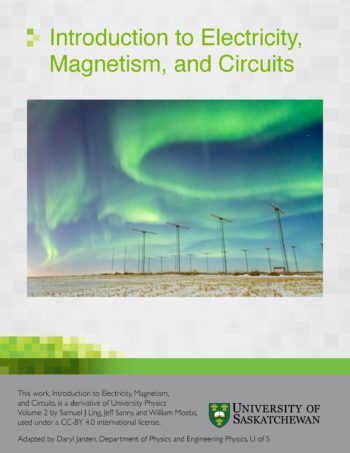
 College Physics by Various Authors (2020): OpenStax.
College Physics by Various Authors (2020): OpenStax.
College Physics meets standard scope and sequence requirements for a two-semester introductory algebra-based physics course. The text is grounded in real-world examples to help students grasp fundamental physics concepts. It requires knowledge of algebra and some trigonometry, but not calculus. College Physics includes learning objectives, concept questions, links to labs and simulations, and ample practice opportunities for traditional physics application problems.
 University Physics by Various Authors (2020): OpenStax.
University Physics by Various Authors (2020): OpenStax.
University Physics is a three-volume collection that meets the scope and sequence requirements for two- and three-semester calculus-based physics courses. Volume 1 covers mechanics, sound, oscillations, and waves. Volume 2 covers thermodynamics, electricity and magnetism, and Volume 3 covers optics and modern physics. This textbook emphasizes connections between theory and application, making physics concepts interesting and accessible to students while maintaining the mathematical rigor inherent in the subject. Frequent, strong examples focus on how to approach a problem, how to work with the equations, and how to check and generalize the result.
Conceptual Physics by Benjamin Crowell (2019): GNU.
For a semester-length course, all seven chapters can be covered. For a shorter course, the book is designed so that chapters 1, 2, and 5 are the only ones that are required for continuity; any of the others can be included or omitted at the instructor’s discretion, with the only constraint being that chapter 6 requires chapter 4.
 Introduction to Electricity, Magnetism, and Circuits by Daryl Janzen (2016): University of Saskatchewan.
Introduction to Electricity, Magnetism, and Circuits by Daryl Janzen (2016): University of Saskatchewan.
This textbook emphasizes connections between theory and application, making physics concepts interesting and accessible to students while maintaining the mathematical rigour inherent in the subject. Frequent, strong examples focus on how to approach a problem, how to work with the equations, and how to check and generalize the result.
 Motion Mountain: The Adventure of Physics - Vol. I: Fall, Flow, and Heat by Christoph Schiller (1990-2020):
Motion Mountain: The Adventure of Physics - Vol. I: Fall, Flow, and Heat by Christoph Schiller (1990-2020):
Christoph Schiller.
This popular book is downloaded over 40 000 times per year. If you are between the age of 16 and 106 and want to understand nature, you will enjoy it! The book promises wonder and thrill on every page: it tells the various puzzles about the colour of the bear and about the picture on the wall, explains about the many types of water waves, introduces the art of laying rope, tells about the dangers of aeroplane toilets, explores the jumping height of different animals, presents the surprising motion of moguls on skiing slopes, explains why ultrasound imaging is not safe for a foetus, gives the ideal shape of skateboard half-pipes and estimates the total length of all capillaries in the human body.
Classical Mechanics (MIT OpenCourseWare)
This first course in the physics curriculum introduces classical mechanics. Historically, a set of core concepts—space, time, mass, force, momentum, torque, and angular momentum—were introduced in classical mechanics in order to solve the most famous physics problem, the motion of the planets.
Classical Mechanics II (MIT OpenCourseWare)
This undergraduate course is a broad, theoretical treatment of classical mechanics, useful in its own right for treating complex dynamical problems, but essential to understanding the foundations of quantum mechanics and statistical physics.
Classical Mechanics III (MIT OpenCourseWare)
This course covers Lagrangian and Hamiltonian mechanics, systems with constraints, rigid body dynamics, vibrations, central forces, Hamilton-Jacobi theory, action-angle variables, perturbation theory, and continuous systems. It provides an introduction to ideal and viscous fluid mechanics, including turbulence, as well as an introduction to nonlinear dynamics, including chaos.
Fundamentals of Physics I (Open Yale)
This course provides a thorough introduction to the principles and methods of physics for students who have good preparation in physics and mathematics. Emphasis is placed on problem solving and quantitative reasoning. This course covers Newtonian mechanics, special relativity, gravitation, thermodynamics, and waves.
Fundamentals of Physics II (Open Yale)
This is a continuation of Fundamentals of Physics, I (PHYS 200), the introductory course on the principles and methods of physics for students who have good preparation in physics and mathematics. This course covers electricity, magnetism, optics and quantum mechanics.
Introduction to Electromagnetism (Saylor)
PHYS102: The physics of the universe appears to be dominated by the effects of four fundamental forces: gravity, electromagnetism, weak nuclear forces, and strong nuclear forces. These forces control how matter, energy, space, and time interact to produce our physical world. All other forces, such as the force you exert in standing up, are ultimately derived from these fundamental forces.
Introduction to Mechanics (Saylor)
PHYS101: Introduction to Mechanics is the first course in the Introduction to Physics sequence. In general, the quest of physics is to develop descriptions of the natural world that correspond closely to actual observations. Given this definition, the story behind everything in the universe, from rocks falling to stars shining, is one of physics. In principle, the events of the natural world represent no more than the interactions of the elementary particles that comprise the material universe. In practice, however, it turns out to be more complicated than that.
Covers, unit by unit, a wide variety of topics related to physics, including the Laws of Motion, gravity, momentum, fluid dynamics, thermodynamics, sound, electricity, magnetism, optics, special relativity, and atomic and nuclear physics.
American Institute of Physics (aip.org)
Andes Physics Tutor (Arizona State University)
CK-12 Physics Simulations (CK12)
College Physics Bookshelf (LibreTexts)
Engineering Physics (Open Course Library)
Gizmos (Explore Learning)
Physics Central (American Physical Society)
Physics Course List (MIT OpenCourseWare)
Physics for Non-Science Majors (Open Course Library)
Physics: OER Commons (OER Commons)
Physics Force Demonstrations (University of Minnesota)
Physics Myths & Physics Facts (Thomas Smid)
Physics Texts (bookboon)
Physics Texts (IntechOpen)